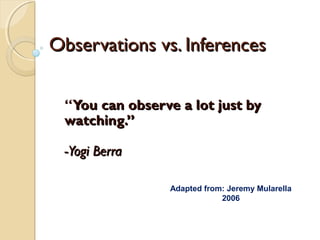Observations vs-inferencespart one
Students often have trouble understanding the difference between observations and inferences. This presentation starts by going over definitions of each term, as well as, the differences between quantitative and qualitative observations. The goal is for students to understand that observations are data, which is used to create inferences (preliminary conclusions) and evidence is when you use the data to support your inferences. A final point is made that inferences are preliminary conclusions, thus inferences can not be seen. The remainder of the presentation gives multiple photos for students to practice making inferences from data. This learning program is geared to K-12 students, but can also be used for introductory college courses in multiple subjects.

Empfohlen
Empfohlen
Weitere ähnliche Inhalte
Was ist angesagt?
Was ist angesagt? (20)
Andere mochten auch
Andere mochten auch (20)
Ähnlich wie Observations vs-inferencespart one
Ähnlich wie Observations vs-inferencespart one (20)
Mehr von jschmied
Mehr von jschmied (20)
Kürzlich hochgeladen
Kürzlich hochgeladen (20)
Observations vs-inferencespart one
- 1. Observations vs. Inferences v2Observations vs. Inferences v2 “You can observe a lot just byYou can observe a lot just by watching.”watching.” -Yogi Berra-Yogi Berra Adapted from: Jeremy Mularella 2006 jschmied 2015
- 2. ObservationsObservations An observation is the gathering of information using our five senses or tools to extend the senses: ◦ Sight ◦ Smell ◦ Hearing ◦ Taste ◦ Touch There are two types of observations ◦ Qualitative – Using Qualities ◦ Quantitative – Using Numbers
- 3. InferencesInferences Inferences are reasonable conclusionsreasonable conclusions made from observations. Inferences are based on your past experiences and prior knowledge. Inferences are often changed when new observations are made. Inferences are reasonableInferences are reasonable conclusions drawn fromconclusions drawn from observationsobservations!!
- 4. Here are some examples!Here are some examples! 1. Observation: The grass on the school’s front lawn is wet. Possible inferences: ◦ It rained. ◦ The sprinkler was on. ◦ There is dew on the grass from the morning. ◦ A dog urinated on the grass! All of these inferences could possibly explain why the grass is wet. Inferences are based on prior experiences. We have all seen rain, sprinklers, morning dew, and dogs going to the bathroom.
- 5. Another example of an inference…Another example of an inference… #2: Observation: The school fire alarm is going off! Possible inferences: ◦ The school is on fire. ◦ We are having a fire drill. ◦ A student pulled the fire alarm. ◦ The cooks burned dinner and there is smoke! Each is a logical, reasonable explanation for why the fire alarm is going off.
- 6. A finalA final example of an inference…example of an inference… # 3: A student is sitting in the main office. Possible inferences: Why might a student be sitting there?
- 7. Qualitative ObservationsQualitative Observations Qualitative observations describe what is observed. “Qualitative” = quality (descriptive) Qualitative observations use adjectives to describe observations and record data. Example: The flower has soft petals. Example: Mr. M is very excitable!
- 8. Quantitative ObservationsQuantitative Observations Quantitative observations measure what is observed. “Quantitative” = quantity (numbers) These observations use numbers to record data. Example: The flower has seven petals. Example: Mr. M weighs 212 pounds.
- 9. Which is better?Which is better? Both types of observations are valuable in science. However, in an experiment quantitative observations can be precisely and objectively compared. Qualitative: The road is very long. (describes) Quantitative: The road is 5 km long. (measures) Scientists use innovative ways to convert qualitative observations into quantitative observations.
- 10. Converting Qualitative observationsConverting Qualitative observations into Quantitative datainto Quantitative data Example: Your big, dead fish is smelly, but how can this smell be measured? How would someone else know how smelly the fish actually is? To solve this problem scientists would make a scale for “smelliness” What about using a scale from 0-5, with a 5 as Nauseating and a 0 for no smell at all. This would allow people to compare how smelly your fish is compared to others!
- 11. Data vs EvidenceData vs Evidence (science)(science) When one collects observations they are taking data. When one is asked to support an inference, the data you use to support the inference is called “Evidence”. One uses the data from observations to create Inferences. (Inferences are sometimes called “preliminary” conclusions since inferences can change with more data)
- 13. Instructions: 1. Create this Data Table on notebook paper. 2. Continue down to 12 slides/stations…
- 14. Instructions:Instructions: 1.1.View each slide or stationView each slide or station very closelyvery closely 2. Write down2. Write down two observationstwo observations. These are. These are interesting itemsinteresting items that you can actually seethat you can actually see beingbeing displayeddisplayed 3. Create3. Create two inferencestwo inferences. Each inference. Each inference should be ashould be a logical , reasonable conclusionlogical , reasonable conclusion drawn from your observations.drawn from your observations. 4. Remember, inferences are “conclusions”4. Remember, inferences are “conclusions” and canand can NOT be seenNOT be seen!! Are You Ready???Are You Ready???
